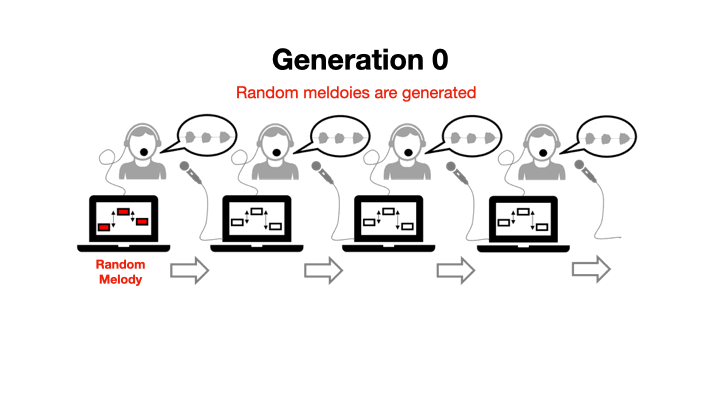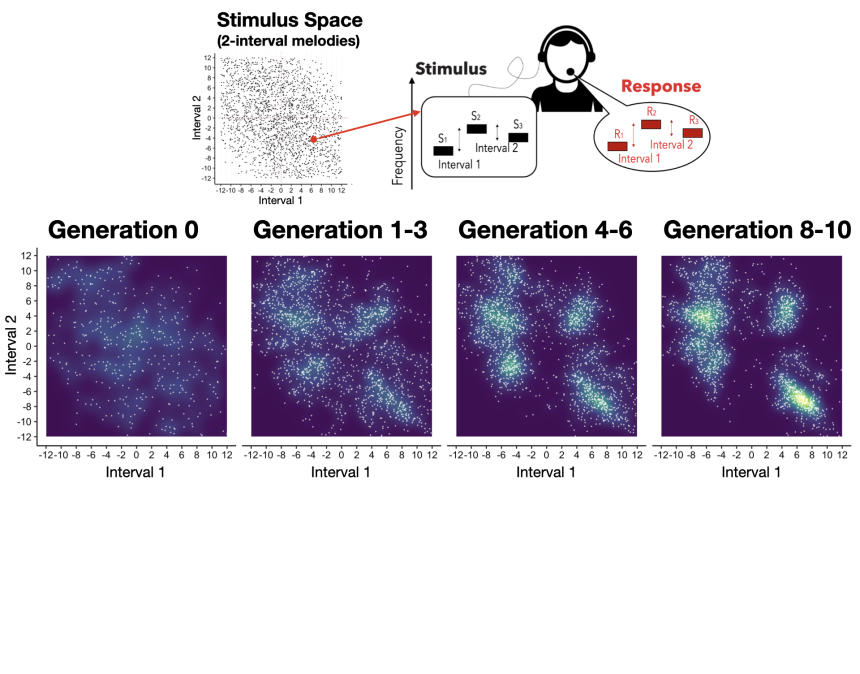
Music and the mind: a profile of Dr Manuel Anglada Tort
 Dr Manuel Anglada Tort. Image credit: University of Oxford.
Dr Manuel Anglada Tort. Image credit: University of Oxford.
Please could you introduce your work?
I am interested in exploring the psychological and cultural foundations of music, and the role they play in human societies and cultural evolution. Music has not evolved from individual brains but instead from being embedded in large cultural processes of multiple social interactions. To understand why music is the way it is, and how we find pleasure in it, we therefore need to consider the collective processes by which music has evolved. To study this, my work combines methods from many different disciplines, including psychology, computer science, musicology, and cultural evolution.
For example, I use singing as a model to study how music evolves when it is transmitted across human generations. Singing is fascinating because it is the most widespread mode of musical expression, practiced by all cultures and ages, even in infants. We developed a novel method to simulate the evolution of music with singing experiments, where sung melodies are passed from one singer to the next, similar to the popular ‘telephone game.’ Using this method, we examine how thousands of musical melodies change and evolve as they are orally transmitted across participants.
What have you found so far?
We found that oral transmission has profound effects on how melodies evolve, shaping initially random sounds into more structured musical systems that increasingly reuse and combine fewer elements, such as certain pitch intervals and simple melodic contours (the sequence of ups and downs in pitch). This ultimately makes the melodies easier to learn and transmit over time. Importantly, the structural features that emerged artificially from our experiments are largely consistent with widespread melodic features found in most musical traditions across the world. This suggests that ‘human transmission biases’ in singing may contribute, at least partly, to the observed cross-cultural commonalities found in many music cultures across the world.
The next stage is to work out which factors are responsible for these ‘transmission biases.’ Our experiments show that physical and cognitive constraints in our capacity to produce and process music are of critical importance. For example, melodies that are hard to sing or remember are systematically less likely to survive the transmission process. We also found that participants’ previous cultural exposure is important. For instance, in a group of US participants, the ‘evolved’ melodies tended to align with certain cultural conventions of Western music, whilst a group of participants from India showed cross-cultural divergences.
Overall, this work is exciting because allows us to study evolutionary processes that are typically hidden or very hard to measure. We are excited to extend this work to study other production modalities, such as speech, as well as to test participants from more diverse musical backgrounds.

Online iterated singing method, developed by Manuel to study how oral transmission affects the evolution of melodies in songs. Participants hear a sequence of tones generated by a computer and reproduce it by singing back. The vocal reproductions are analysed by a computer and played to the next participant as the input melody. This process is repeated with many parallel transmission chains at the same time, each corresponding to a melody evolving over 10 generations. Image credit: Manuel Anglada Tort.
We talk of the culture of music but essentially, music is culture. Just as we cannot understand culture by only looking at individual brains, we cannot understand music without considering the larger cultural and social processes surrounding it.
For your PhD at the Technical University of Berlin, you studied how behavioural economics can be applied to music cognition. What did you find?
Behavioural economics recognises that human beings do not always think through every decision rationally. For example, we often rely on cognitive heuristics to simplify complex decisions: mental shortcuts that allow us to use information selectively and effectively.
In my PhD, I showed that, when it comes to music decisions and preferences, the context in which music is presented has a very important influence. Our preferences for music will change dramatically depending on the time and day of the week, which activity we do while listening to music, whether we are alone or with others, and what information we know about the artists’ skills and persona. Even small variations on the title of a song can have an important impact on how much people like the music.
In one experiment, we showed that contextual factors can completely change our experience of the same piece of music. We told participants to listen to ‘different’ musical performances of an original piece when in fact they were exposed to the same repeated recording three times. Each time, the recording was accompanied by a different text providing information about the supposed performer, which was manipulated to indicate either low or high prestige of the performer. We found that most participants (75%) believed that they had heard different musical performances. Interestingly, participants evaluated identical recordings more positively in terms of liking and music quality when they thought the music was performed by a professional musician rather than a less-skilled musician. This suggests that when we judge music, we rely on cognitive biases and heuristics that do not always depend on what we actually hear.
The results of our studies suggest that when we judge music, we rely on cognitive biases and heuristics that do not always depend on what we actually hear.
You have also worked as a science consultant for an audio branding firm. What exactly does audio branding involve?
Audio branding is where brands translate their identity and values into audible elements that are then repeated in their advertisements or used within their products. As we are increasingly saturated with visual information, companies are showing a growing interest in using audio branding to reach target audiences. For example, repeated catchy melodies of three to five notes can be highly effective in making people recognise a brand or product, such as the iconic audio logos of McDonald’s or Netflix. As researchers, we can quantify the effectiveness of different music when paired with certain commercials or brands, for example by measuring the impact of music on consumers’ brand recognition or purchase intention.
In one study, we found that pairing brands with music that can be recognized by the target consumers increased brand choice by 6%. Although this is a small effect, it is quite remarkable given that using music is relatively easy and cheap for brands. But the use of advertising music is becoming much more sophisticated with AI and big data. The future of music and advertising is about creating individualised consumer experiences where the same ads and products can be paired with different music targeting the many individual preferences of consumers.
 Oral transmission effects on melodies. The entire stimulus space of three-note melodies (two intervals) can be defined along two continuous dimensions, one for each interval in the melody (with each dot representing a melody). At the start of the experiment (Generation 0), hundreds of melodies were randomly sampled from this space. These melodies were then played to participants, who were asked to reproduce them by singing. Over time, oral transmission shaped initially random melodies into more structured and simplified musical systems. By the end of the experiment (Generation 8-10), melodies were concentrated in few locations, displaying a rich structure that is consistent with Western discrete scale systems. Image credit: Manuel Anglada Tort.
Oral transmission effects on melodies. The entire stimulus space of three-note melodies (two intervals) can be defined along two continuous dimensions, one for each interval in the melody (with each dot representing a melody). At the start of the experiment (Generation 0), hundreds of melodies were randomly sampled from this space. These melodies were then played to participants, who were asked to reproduce them by singing. Over time, oral transmission shaped initially random melodies into more structured and simplified musical systems. By the end of the experiment (Generation 8-10), melodies were concentrated in few locations, displaying a rich structure that is consistent with Western discrete scale systems. Image credit: Manuel Anglada Tort.Music is essentially a psychological phenomenon: our mind has evolved to translate physical qualities of sound into the subjective experience of music.
How did you get in to music psychology?
I have always loved playing and composing music, but my academic career originally started in psycholinguistics and experimental psychology, studying the bilingual brain. I then happened to find out about this small research field in music psychology. For me, music and science seemed the perfect combination, so I applied to Goldsmiths, University of London, to study their MSc in Music, Mind and Brain.
It was revolutionary for me to realise that all the scientific methods I had learnt for experimental psychology could be applied to study music as well; working out how we perceive sound and get pleasure from it, and the many psychological functions that music making and listening have. I remember the lectures on psychoacoustics to be particularly inspiring, where I learnt that music is essentially a psychological phenomenon: our mind has evolved to translate physical qualities of sound into the subjective experience of music. For example, we perceive pitch from the speed at which an object vibrates: the faster the vibration, the higher our perception of pitch. By combining different sets of music pitches, we can in theory create infinite music patterns. Some of these patterns will become popular in a given population, whereas others will die out.
I feel very fortunate that this work is a fusion of three key interests of mine: science, music and culture.
What plans do you have for the Music, Culture, and Cognition group in the near future?
I am excited about the potential of this group, and I feel very fortunate to have an incredible network of international collaborators with expertise in music cognition and cultural evolution. The idea is to continue to perform cutting-edge research on the intersection between music, culture, and cognitive science here at the University of Oxford. This will include continuing our experiments to simulate cultural evolution (such as the singing transmission study) and extending these methods to also study more complex cultural phenomena. For example, to study how the evolution of musical structures may depend on selection pressures (e.g. composers vs critics vs consumers) or underlying population structures, such as social networks and their different patterns of connectivity.
Another exciting line of research is on the topic of cultural globalization and popularity dynamics: exploring how songs spread across the world and what determines whether a song will become a global hit or not (also known as ‘Hit Song Science’). Traditionally, people have attempted to predict music success based only on the content of the music: its harmony, timbre, or rhythm. But studies have repeatedly failed to predict musical success based on musical features alone. I believe that the distribution network by which music spreads within and across countries may help solve this puzzle. So, we are investigating ways to measure and quantify this underlying network of music diffusion and its impact on cultural globalization.
You arrived here less than two months ago – what do you make of Oxford so far?
Oxford is an incredible place and I feel very privileged to be here. Unlike ‘campus’ universities, you feel that the whole city itself is the university; you sense it all around you. The musical scene is excellent (which is important to me) and more generally, it feels that this is a place where anything you might want to do is possible – from life drawing, to dancing, to playing any kind of instrument. I have already found a group of friends to go rock climbing with and recently got into bird watching for the first time. I have also fallen in love a bit with the English pub culture. Coming from Spain, I had never seen anything like them before, and am fascinated by how they are all so different and have so much history. I am looking forward to exploring all the ones in Oxford over time!
You can read Dr Manuel Anglada Tort's latest research paper 'Large-scale iterated singing experiments reveal oral transmission mechanisms underlying music evolution' in the journal Current Biology.
In the video below, Manuel Anglada Tort describes his work to study the effect of oral transmission on music evolution using online singing experiments, in an event for the Oxford Seminar in the Psychology of Music.
 10 years on: The Oxford learning centre making an impact
10 years on: The Oxford learning centre making an impact Oxford and The Brilliant Club: inspiring the next generation of scholars
Oxford and The Brilliant Club: inspiring the next generation of scholars New course launched for the next generation of creative translators
New course launched for the next generation of creative translators The art of translation – raising the profile of languages in schools
The art of translation – raising the profile of languages in schools  Tracking resistance: Mapping the spread of drug-resistant malaria
Tracking resistance: Mapping the spread of drug-resistant malaria Cities for cycling: what is needed beyond good will and cycle paths?
Cities for cycling: what is needed beyond good will and cycle paths?